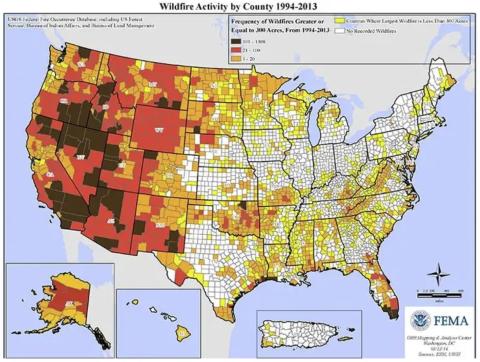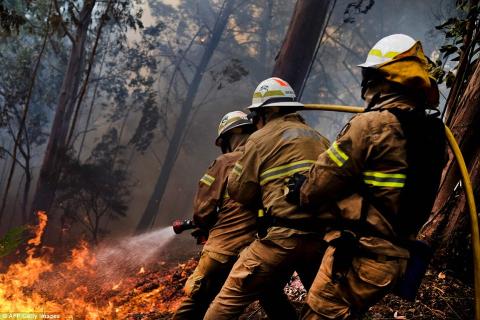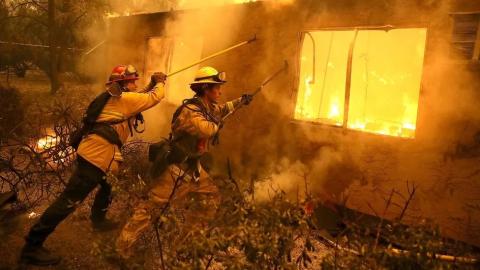Artificial Intelligence in Wildfire Prevention
June 30, 2023Wildfires and forest fires are an unfortunate reality in our everyday lives. While California may be a first thought when it comes to wildfires (as this state is often spotlighted in the news), these fires can happen anywhere across the world, with areas in the West, East of the Rockies, and parts of the Plains and South seeing the highest frequency of wildfires. Conversely, the recent wildfires of Nova Scotia, Canada and New Jersey are currently a hot topic of local news, as these fires are some of the worst these areas have seen in history and they have been affecting most of the East Coast instead of the West. As a result of the massive burning from up north and specific wind conditions, smoke continues to travel down from state-to-state, generating poor air quality and a noticeable burning smell. At-risk people, such as those who are pregnant or have asthma, are advised to stay indoors to avoid the stifling conditions that persist in East Coast areas and are causing a haziness of smoggy air over the horizon. The 90-degree weather in many areas isn’t helping either, and global warming is believed to be a significant player in the worsening factors that contribute to wildfire conditions. These uncontrollable fires happen by several means, both natural and unnatural, and though the prevention of these fiery forces has been long researched, it continues to be a struggle in managing, preventing, and putting a stop to the unyielding flames.
Common Causes of Wildfires
Wildfires can stem from natural and unnatural phenomenon. For example, it is estimated that 60% of wildfires are caused by lightning strikes to trees and the ground that ignite dry grass and other susceptible structures and spread quickly. Global warming may be attributable to these conditions as well, as the fire season seems to be lasting longer with shorter fall and longer spring/summer seasons. The heat and dryness of these months creates the perfect breeding ground for wildfires and cause more violent lightning storms, more so than those typically seen in the summer. CBS News notes that “a one-degree Celsius increase in temperature amounts to about 12% more lightning,” making it so that any variation in climate conditions can drastically impact wildfire potential. Other causes of wildfire are more preventable, as they are started by humans either intentionally or unintentionally. Improperly quelching a campfire, tossing lit cigarettes, and controlled land burns, especially during a fire warning (an alert that conditions are particularly dry lending to a wildfire risk), are all additional possible causes of wildfires.
A History of Prevention
Wildfires are truly a force to be reckoned with, and there has been extensive exploration into new regulations and technology for wildfire prevention and mitigation with varied success over the decades.
Wildfires prevention was first addressed in 1648, when the first fire inspectors were appointed in New York, and a civilian brigade was formed to respond in the event of a wildfire. This tactic is being revisited today in Canada after the recent rampant wildfires, and local authorities are looking to establish a team of reserve civilian firefighters that can seamlessly take over for the regular staff when a wildfire goes on for more than a few weeks.
In 1993, the National Fire Protection Association (NFPA) established the first safety protocols for the protection of said fire fighters in wildfire scenarios, including indications on what equipment and gear is should be used.
When a wildfire starts, it is nearly impossible to track unless signs are first noticed by a passerby, a surveillance camera, or satellite, depending on the initial size of the flame or smoke cloud. This is where AI can assist, using algorithms and recognition software to target and track the wildfire from start to finish.
Before AI usage, preparation and planning were primarily used to help in terms of creating physical barriers to the spread of wildfires, like roads, railways, and non-flammable dividers.
In the field, fire fighters must try to prevent the fire from spreading, but usually by the time they reach it, it is too late. Next steps would include a full attack from land and sky, using fire fighters and aircraft to throw water and fire-retardant chemicals at the flames to get them under control. Eventually, the fires are subdued, but the damage is already done.
While there have been significant advancements in this area, the problem with current wildfire fighting methods is multi-fold. First, there have not been any significant changes in the approach in several decades. For example, a product referred to as firefighting foam, or aqueous film-forming foam (AFFF), was first introduced in 1902 and is still used today. It works as a layer of material that is used to coat the ground and fires to prevent oxygen from feeding the flames. This is, in theory, an effective means to addressing the fires, but at a cost. Scientific studies and statements by the CDC and EPA confirm that some of the chemicals used AFFF material are perfluoroalkyl and polyfluoroalkyl substances (PFAS), which can be cancer-causing to firefighters and those who work with, or near, the substance. Additionally, there are also possible long-term ecological and environmental risks in using this material. Secondly, the planning of large-scale projects in prevention requires political support and takes several decades to come to fruition, and competing priorities within agencies can derail such initiatives. Weather.com states that “in 2022, the Forest Service missed its treatment goals in four of 10 areas targeted as priorities,” showing that even with proper government funding, actual execution of these projects can be difficult to achieve.
And most notably, wildfire fighting is an exhausting process that requires an abundance of support, resources, and manpower for several months and costs billions of dollars, with several lives, wildlife, and properties lost.
The need for better management and prevention persists, and this is where artificial intelligence can help.
Artificial Intelligence Against Wildfires
AI is a surprising and unsuspecting weapon against wildfires. Many would not think that the two fields relate or could benefit from each other. But according to the World Economic Forum, scientists “believe it offers promising applications to pre-, intra- and post-wildfire events” and when “combined with end-to-end fire management systems, are powerful tools for combating wildfires.” In fact, from 1996 to 2019, over 300 scientific articles have been published on the topic, showing that research and interest in the area is increasing with goals towards resolutions.
There are many aspects of wildfire prevention that need to be addressed with better tools and innovative thinking, as it remains evident that wildfires still pose an uncontrolled threat to everyday society. These aspects include risk management, prevention, forecasting and detection, and rapid response. Creating a sharable algorithm to be used collaboratively by professionals in the field can help mitigate wildfires early, in conjunction with the big data we now have access to such as maps, satellite imagery, weather, wind patterns, and social media. That’s right – social media users can help in quickly locating where a wildfire is based on information posted and shared.
The World Economic Forum adds that “all of these systems and algorithms need to be integrated to build a smart framework: a dynamic wildfire risk map with an interactive fire spread simulation and a dynamic decision support system for disaster response and resource allocation.” This would ensure that no time is wasted weeding through disjointed content and private data, but rather, it would be open-sourced and integrated into one seamless system for instant information that lends to a quicker wildfire response.
There are some systems that are in use currently. NASA’s Earth Science Data Systems (ESDS) and other agency initiatives offer unrestricted access to fire information, weather reports, satellite imagery, and relevant data for professionals to address this ongoing problem.
Projects like FireAId are underway to fill in the gaps for wildfire prevention and provide innovative solutions, though countries both individually and internationally have yet to find a definitive method of action or means of working together on this global issue.
The New York Times adds that AI can help prevention in more ways. For example, AI can predict using algorithms where a controlled burn should happen, and when the fuel levels get too high in one area. The University of California’s WIFIRE Lab is working on these initiatives as well and has developed an integrated map complete with filters and other user-friendly ways for scientists and non-scientists to access and analyze wildfire data.
It is only through collaborative efforts and innovative technology solutions, both behind the scenes and at the frontlines, that the threat of wildfires can become an issue of the past.
Education in Artificial Intelligence
Working with big data, machine learning algorithms, and AI requires higher education in these complex areas of study. Capitol Technology University offers Bachelor’s, Master’s, and Doctoral programs in these fields that focus not only on the technical skills needed, but also the global perspective and future implications of these areas. Our expert faculty have worked in the field and teach based on real-world applications in the workplace, and our innovative labs provide an environment for hands-on learning for skills development. Our university also partners with leading tech companies and government agencies like NASA and the US Space Command to ensure our students have access to internships and networking opportunities for job relevant experience.
For more information, contact our admissions department or visit our website.
Common Causes of Wildfires
Wildfires can stem from natural and unnatural phenomenon. For example, it is estimated that 60% of wildfires are caused by lightning strikes to trees and the ground that ignite dry grass or other structures and spread quickly. Global warming may be attributable to these conditions as well, as the fire season seems to be lasting longer with shorter fall and longer spring/summer seasons. The heat and dryness of these months creates the perfect breeding ground for wildfires and cause more violent lightning storms, more so than those typically seen in the summer. CBS News notes that “a one-degree Celsius increase in temperature amounts to about 12% more lightning,” making it so that any variation in climate conditions can drastically impact wildfire potential. Other causes of wildfire are more preventable, as they as started by humans either intentionally or unintentionally. Improperly quelching a campfire, tossing lit cigarettes, and controlled land burns, especially during a fire warning (an alert that conditions are particularly dry lending to a wildfire risk), are all additional causes of wildfires.
A History of Prevention
Wildfires are truly a force to be reckoned with, and there has been extensive exploration into new regulations and technology for wildfire prevention and mitigation with varied success over the decades.
In 1648, the first fire inspectors were appointed in New York, and a civilian brigade was formed to respond in the event of a wildfire. This tactic is being revisited today in Canada after the recent rampant wildfires, and local authorities are looking to establish a team of reserve civilian firefighters that can seamlessly take over for the regular staff when a wildfire goes on for more than a few weeks.
In 1934, “smokejumping” was developed as a method for firefighters so they can parachute into areas of destruction in order to quickly access wildfires.
In 1993, the National Fire Protection Association (NFPA) established the first safety protocols for the protection of fire fighters in wildfire scenarios, including what equipment and gear is needed.
When a wildfire starts, it is usually first noticed by a passerby, via camera, or satellite, depending on its size. This is where AI can assist, with algorithms and recognition.
Preparation and planning can help in terms of creating barriers to the spread of wildfires, like roads, railways, and non-flammable dividers.
Fire fighters try to prevent the fire from spreading, but by the time they reach it, it is often too late. Next steps include a full attack from land and sky, using fire fighters and aircraft to throw water and fire-retardant chemicals at the flames to get them under control. Eventually, the fires are subdued, but the damage is already done.
While there have been significant advancements in this area, the problem with current wildfire fighting methods is multi-fold. First, there have not been any significant changes in the approach in several decades. A product referred to as firefighting foam, or aqueous film-forming foam (AFFF), was first introduced in 1902. It works as a layer of material that is used to coat the ground and fires to prevent oxygen from feeding the flames. This is in theory, an effective means to addressing the fires, but at a grave cost. Scientific studies and statements by the CDC and EPA confirm that some of the chemicals used AFFF material are perfluoroalkyl and polyfluoroalkyl substances (PFAS), which can be cancer-causing to firefighters and those who work with, or near, the substance. Additionally, there are also possible long-term ecological and environmental risks in using this material. Secondly, the planning of large-scale projects in prevention requires political support and takes several decades to come to fruition, and competing priorities within agencies can derail such initiatives. Weather.com states that “in 2022, the Forest Service missed its treatment goals in four of 10 areas targeted as priorities,” showing that even with proper government funding, actual execution of these projects can be difficult to achieve.
And most notably, wildfire fighting is an exhausting process that requires an abundance of support, resources, and manpower for several months and costs billions of dollars, with several lives, wildlife, and properties lost.
The need for better management and prevention persists, and this is where artificial intelligence can help.
Artificial Intelligence Against Wildfires
AI is a surprising and unsuspecting weapon against wildfires. Many would not think that the two fields relate or could benefit from each other. But according to the World Economic Forum, scientists “believe it offers promising applications to pre-, intra- and post-wildfire events” and when “combined with end-to-end fire management systems, are powerful tools for combating wildfires.” In fact, from 1996 to 2019, over 300 scientific articles have been published on the topic, showing that research and interest in the area is increasing with goals towards resolutions.
There are many aspects of wildfire prevention that need to be addressed with better tools and innovative thinking, as it remains evident that wildfires still pose an uncontrolled threat to everyday society. These aspects include risk management, prevention, forecasting and detection, and rapid response. Creating a sharable algorithm to be used collaboratively by professionals in the field can help mitigate wildfires early, in conjunction with the big data we now have access to such as maps, satellite imagery, weather, wind patterns, and social media. That’s right – social media users can help in quickly locating where a wildfire is based on information posted and shared.
The World Economic Forum adds that “all of these systems and algorithms need to be integrated to build a smart framework: a dynamic wildfire risk map with an interactive fire spread simulation and a dynamic decision support system for disaster response and resource allocation.” This would ensure that no time is wasted weeding through disjointed content and private data, but rather, it would be open-sourced and integrated into one seamless system for instant information that lends to a quicker wildfire response.
There are some systems that are in use currently. NASA’s Earth Science Data Systems (ESDS) and other agency initiatives offer unrestricted access to fire information, weather reports, satellite imagery, and relevant data for professionals to address this ongoing problem.
Projects like FireAId are underway to fill in the gaps for wildfire prevention and provide innovative solutions, though countries both individually and internationally have yet to find a definitive method of action or means of working together on this global issue.
The New York Times adds that AI can help prevention in more ways. For example, AI can predict using algorithms where a controlled burn should happen, and when the fuel levels get too high in one area. The University of California’s WIFIRE Lab is working on these initiatives as well and has developed an integrated map complete with filters and other user-friendly ways for scientists and non-scientists to access and analyze wildfire data.
It is only through collaborative efforts and innovative technology solutions, both behind the scenes and at the frontlines, that the threat of wildfires can become an issue of the past.
Education in Artificial Intelligence
Working with big data, machine learning algorithms, and AI requires higher education in these complex areas of study. Capitol Technology University offers Bachelor’s, Master’s, and Doctoral programs in these fields that focus not only on the technical skills needed, but also the global perspective and future implications of these areas. Our expert faculty have worked in the field and teach based on real-world applications in the workplace, and our innovative labs provide an environment for hands-on learning for skills development. Our university also partners with leading tech companies and government agencies like NASA and the US Space Command to ensure our students have access to internships and networking opportunities for job relevant experience.
For more information, contact our admissions department or visit our website.






